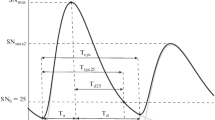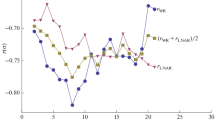Abstract
Using a series with a rather small statistic of events, Gnevyshev and Ohl have proposed to combine 11-year cycles of the solar activity (SA) in individual physical pairs of even–odd, where the relative intensity of the odd cycle is higher than that of the previous even cycle. However, this rule can be valid only at ascending phases of a longer and more powerful quasi-bicentennial (QB) cycle, when the intensity of each successive 11-year cycle exceeds that of the previous cycle, and be violated in the QB decline phase, when, on the contrary, the power of each subsequent cycle becomes less than the previous one. The quasi-bicentennial cycle, which is longer by more than an order of magnitude and significantly more powerful, determines and controls both the physical parameters and the consecutive variations in the intensity of short and weak quasi-11-year SA cycles depending on the phase of QB variations. At descending QB phases, the length of 11-year SA cycles consecutively increases, while the level of their maxima and the relative integral power consecutively decreases. An opposite behavior is observed at ascending QB phases. Here it is stated for the first time that the Gnevyshev–Ohl rule results from the consecutive growth in integral powers of short 11-year cycles and remains valid only at ascending phases of the QB cycle; the rule becomes broken by the consecutive decrease in powers of 11-year cycles occurring at descending QB phases. In XXV and XXVI cycles observed during the descending QB phase, the trend of a consecutive decrease in heights of SA maxima will persist to 110 ± 25 and 60 ± 35 (to 65 ± 15 and 35 ± 20 by the version 1.0 of sunspot counting) relative sunspot numbers, respectively.




Similar content being viewed by others
REFERENCES
M. N. Gnevyshev and A. I. Ohl, Astron. Zh. 25, 18 (1948).
H. I. Abdussamatov, Kinem. Phys. Cel. Bodies 21, 328 (2005).
Y. A. Nagovitsyn, E. Y. Nagovitsyna, and V. V. Makarova, Astron. Lett. 35, 564 (2009).
N. V. Zolotova and D. I. Ponyavin, Geomag. Aeron. 55, 902 (2015).
A. G. Tlatov, Astrophys. J. Lett. 772, L30 (2013).
B. Komitov and B. Bonev, Astrophys. J. 554, L119 (2001).
V. N. Obridko, Sol. Phys. 156, 179 (1995).
O. G. Badalyan and V. N. Obridko, Mon. Not. R. Astron. Soc. 466, 4535 (2017).
R. P. Kane, Ann. Geophys. 26, 3329 (2008).
H. I. Abdussamatov, Kinem. Phys. Cel. Bodies 23, 97 (2007).
H. I. Abdussamatov, Kinem. Phys. Cel. Bodies 22, 141 (2006).
H. I. Abdussamatov, Proc. IAU Symp. 223, 541 (2004).
V. Trimble, M. J. Aschwanden, and C. J. Hansen, Space Sci. Rev. 132, 1 (2007).
E. P. Borisenkov, Climate Fluctuations over the Last Millennium (Gidrometeoizdat, Leningrad, 1988) [in Russian].
A. I. Shapiro, W. Schmutz, E. Rozanov, et al., Astron. Astrophys. 529, A67 (2011).
T. Egorova, W. Schmutz, E. Rozanov, et al., Astron. Astrophys. 615, A85 (2018).
M. Waldmeier, Astron. Mitteilung. Eidgenöss. Sternw. Zürich 14, 105 (1935).
Sunspot Number, Version 2.0: New Data and Conventions. https://wwwbis.sidc.be/silso/newdataset.
H. I. Abdussamatov, Geomagn. Aeron. 61, 978 (2021).
M. I. Pudovkin and E. E. Benevolenskaya, Sov. Astron. Lett. 8, 273 (1982).
E. H. Levy and D. Boyer, Astrophys. J. Lett. 254, L19 (1982).
H. I. Abdussamatov, in Proceedings of the 25th All-Russia Conference on Physics of the Sun: Solar and Solar–Earth Physics—2021 (St. Petersburg, 2021).
K. J. Li, H. S. Yun, and X. M. Gu, Astron. Astrophys. 368, 285 (2001).
Author information
Authors and Affiliations
Corresponding author
Additional information
Translated by V. Badin
Rights and permissions
About this article
Cite this article
Abdussamatov, H.I. On the Incorrectness of the Gnevyshev–Ohl Rule Combining Even–Odd 11-Year Cycles of the Solar Activity in Physical Pairs and on the Maxima of XXV and XXVI Cycles. Astron. Rep. 66, 701–709 (2022). https://doi.org/10.1134/S1063772922090013
Received:
Revised:
Accepted:
Published:
Issue Date:
DOI: https://doi.org/10.1134/S1063772922090013




